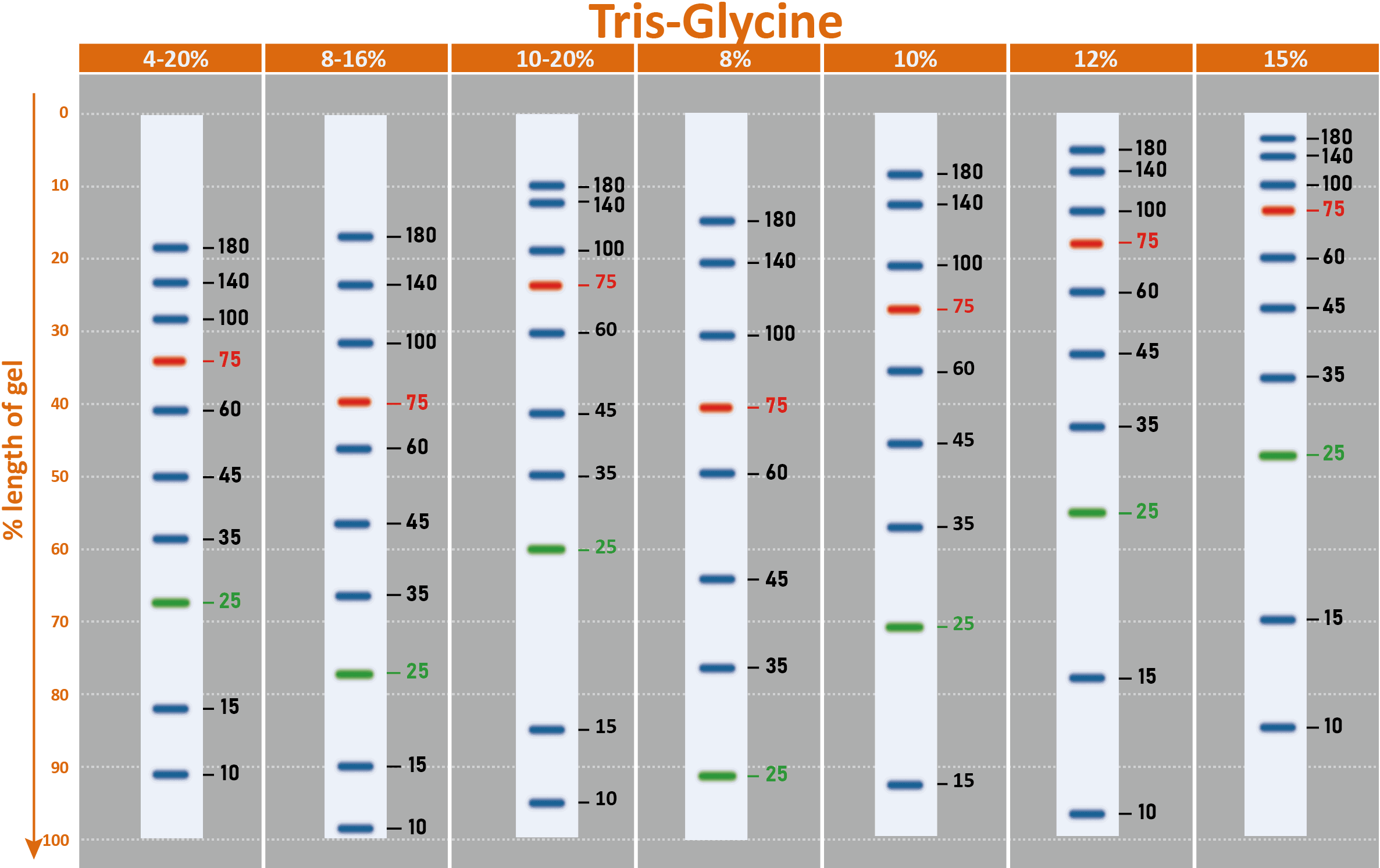[PM2500] ExcelBand™ 3-color Regular Range Protein Marker (9-180 kDa), 250 μl x 2
Description
The PM2500 ExcelBand™ 3-color Regular Range Protein Marker is a ready-to-use three-color protein standard with 10 pre-stained proteins covering a wide range of molecular weights from 10 to 180 kDa in Tris-Glycine Buffer (9 to 170 kDa in Bis-Tris (MOPS) buffer and 10 to 170 kDa Bis-Tris (MES) buffer). Proteins are covalently coupled with a blue chromophore except for two reference bands (one green and one red band at 25 kDa and 75 kDa respectively) when separated on SDS-PAGE (Tris-Glycine buffer). PM2500 ExcelBand™ 3-color Regular Range Protein Marker is designed for monitoring protein separation during SDS-polyacrylamide gel electrophoresis, verification of Western transfer efficiency on membranes (PVDF, nylon, or nitrocellulose) and for approximating the size of proteins.
Features
Ready-to-use — Premixed with a loading buffer for direct loading, no need to boil.
Two reference bands — 75 kDa (red) and 25 kDa (green)
Contents
Approximately 0.1~0.4 mg/ml of each protein in the buffer (20 mM Tris-phosphate (pH 7.5 at 25°C), 2% SDS, 0.2 mM DTT, 3.6 M urea, and 15% (v/v) glycerol).
Quality Control
Under suggested conditions, PM2500 ExcelBand™ 3-color Regular Range Protein Marker resolves 10 major bands in 15% SDS-PAGE (Tris-Glycine buffer, MOPS, and MES buffer) and after Western blotting to nitrocellulose membrane.
Storage
4°C for 3 months
-20°C for long term storage
Specification
Cat. No. | PM2500 |
Series Name | ExcelBand™ |
Product Size | 250 μl x 2 |
MW Range | 10 – 180 kDa |
Band Number | 10 |
Band Color | Red/Green/Blue |
Markered Bands | 25, 75 kDa |
Manual
Manual_PM2500_ExcelBand™ 3-color Regular Range Protein Marker (2023 ver. 2.4.0)
SDS
Migration patterns and approximate MWs (kDa)
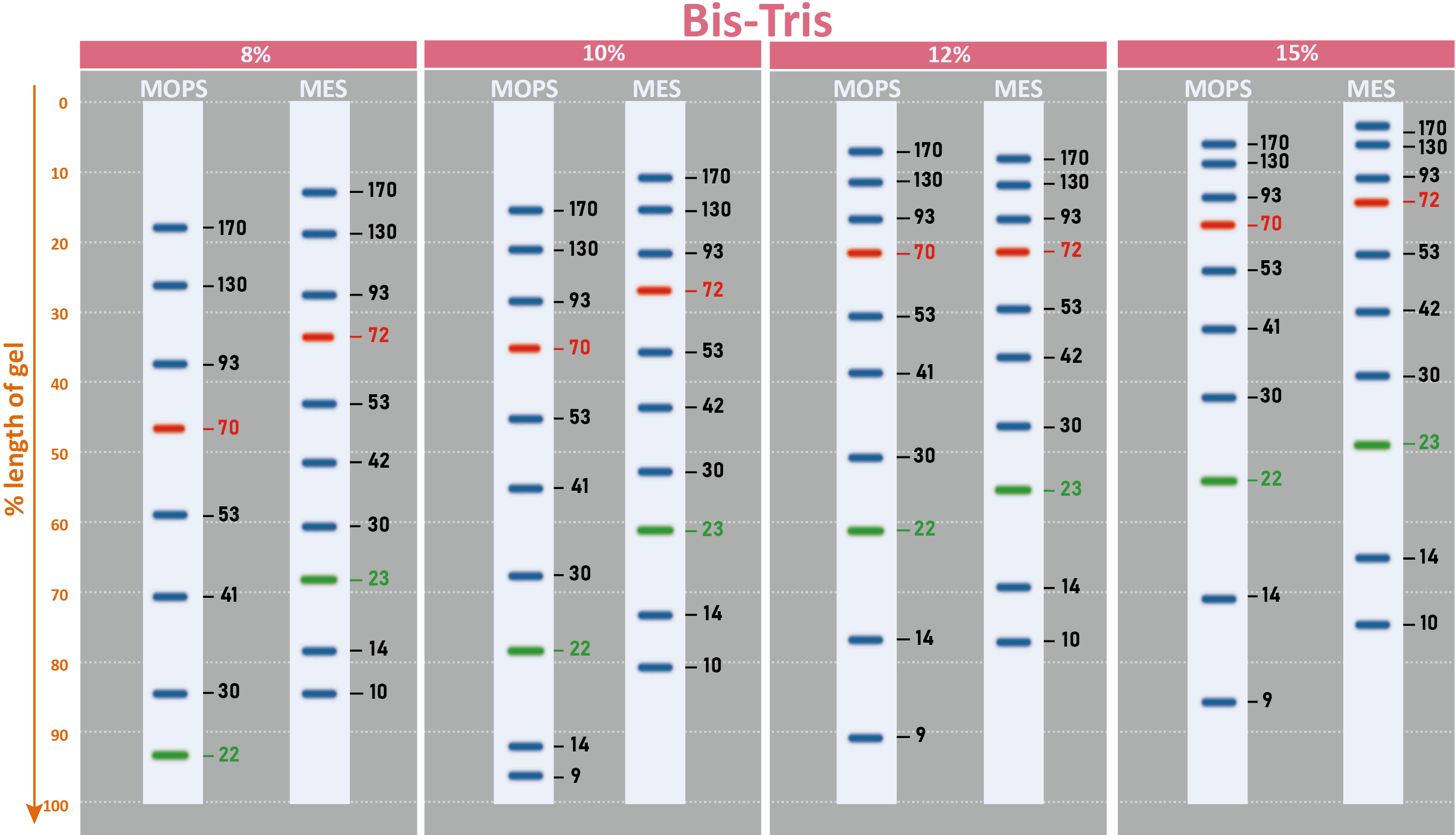
Why are there contrasting results in molecular weights after using different brands of protein markers?
A. Different proteins even with similar molecular weights would exhibit apparent disparity from the resulting SDS PAGE due to the difference in the composition of the protein’s amino acids (e.g. gelatin). The reason for the disparity is due to the amino acids composition that affects the binding of the protein and SDS. Therefore, we can say that protein marker is a handy tool to estimate molecular weight, but there is no absolute molecular weight standard.
B. While running SDS-PAGE, protein mobility can be affected by the composition of the buffer used, gel percentage, the voltage used, running time, as well as if there is a pre-run.
C. Another recommendation for high molecular weight proteins is to prolong the running time to clarify the relative location of bands.
Protein marker Retention Period: Mentioned -20°C and over 2 years. Is it available for 30 months or 36 months? Have you tested this period?
Yes, we have tested our PM2700. The results showed that the PM2700 is stable at -20℃ for at least two years. It has also shown strong performance for more than 36 months under our careful storage. However, we must only suggest a 2 year retention period for the following reasons: There may be a variation in the environment in storage, and improper use may lead to accumulated damage to the proteins and therefore reduce its retention period.
How many times of freezing and thawing are available for protein markers? If it uses 5 μL per load, would the total usage quantity be 50 times x 2 (250 μL x 2 tube)?
Yes, 100 uses (5 μL each time) can be expected if freezing and thawing are conducted carefully and properly at the appropriate temperature. Before each use, make sure the protein marker is thoroughly thawed.
Do you have data comparison for protein molecular weight’s precision with other protein markers?
Yes. Usually, pre-stained marker is written on “estimated molecular weight” for caution. It is known that the analysis of protein size by an SDS-PAGE is only for “estimation” because of the intrinsic variation of amino acid composition in all proteins including stained and non-stained ones. For example, a protein which is highly hydrophilic might show a particular higher position in the SDS-PAGE analysis when compared to a hydrophobic one. We did compare the migration patterns of SMOBIO’s Protein Markers with other brands, and we concluded that it was difficult to define “precision” due to the reasons mentioned above. Therefore, in the product description, we suggest our users to calibrate the MW against their interested proteins. Although it is impossible to define "precision" for molecular weight of proteins in SDS-PAGE, we did compare the migration pattern of pre-stained markers with unstained protein marker (Invitrogen MARK12) for calibration. It is concluded that the estimated molecular weight of SMOBIO’s pre-stained marker shows a curve matching well with that of unstained native proteins (MARK12), representing a good estimation of the MW of each pre-stained protein in the SDS-PAGE analysis.
Will SMOBIO’s Protein Markers/Ladder be washed out during Western blotting process?
SMOBIO’s Protein Markers/Ladder will be only slightly washed out during Western blotting process. However, the excess of Tween-20 (more than 0.2%) in washing buffer will affect SMOBIO’s Protein Markers/Ladder on the transfer membrane.
Here are suggestions for Western blotting process:
1. Transfer SMOBIO’s Protein Markers/Ladder to membrane with transfer buffer containing 20% methanol to fix SMOBIO’s Protein Markers/Ladder on membrane.
2. Wash membrane with PBS or TBS containing less than 0.1% Tween-20.
Will SMOBIO’s Protein Markers/Ladder be affected by the stripping/deprobing process with the presence of β-Mercaptoethanol (β-ME)?
In normal circumstances, the presence of βME during the stripping/deprobing process will only slightly affect SMOBIO’s Protein Markers/Ladder. However, the presence of Tween-20 on PVDF membrane during the stripping/deprobing process has adverse effects on SMOBIO’s Protein Markers/Ladder.
Here are suggestions for Western stripping/deprobing process:
1. Wash the PVDF membrane in methanol for 5~10 minutes prior to the stripping/deprobing process to mitigate the adverse effect of Tween-20.2. Recommended stripping buffer (for 1 L):
15 g glycine,
1 g SDS,
10 mL Tween 20.
Dissolve in 800 mL distilled water.
Adjust pH to 2.2
Bring volume up to 1 L with distilled water
Shamshirgaran MA, Golchin M.
BMC Vet Res. 2025 Mar 14;21(1):167. doi: 10.1186/s12917-025-04624-z.
PMCID: PMC11907976
Protocol for generation of PD modeling induced neurons and detection of alpha-synuclein forms.
Nardi FV, Maisumu G, Zhou Y, Liang B, Yakoub AM.
STAR Protoc. 2024 Dec 20;5(4):103447. doi: 10.1016/j.xpro.2024.103447. Epub 2024 Nov 15.
PMCID: PMC11609654
Wang Y, Harada S, Goshima Y, Ohshima T. Neuromolecular Med. 2024 Sep 12;26(1):37. doi: 10.1007/s12017-024-08805-1.
PMCID: PMC11393028
Yang-Chen Lin, Ya-Jyun Liang, Chun-Hong Zhang, Li-Jia Liu, Feng-Huei Lin Antioxidants (Basel). 2024 Jul 10;13(7):826. doi: 10.3390/antiox13070826.
PMCID: PMC11273629
Nature-inspired peptide of MtDef4 C-terminus tail enables protein delivery in mammalian cells
Lucia Adriana Lifshits, Yoav Breuer, Marina Sova, Sumit Gupta, Dar Kadosh, Evgeny Weinberg, Zvi Hayouka, Daniel Z. Bar, Maayan Gal
Sci Rep. 2024; 14: 4604. Published online 2024 Feb 26. doi: 10.1038/s41598-024-55274-4
PMCID: PMC10897151
Method for plasmid-based antibiotic-free fermentation
Katherine E. Brechun, Marion Förschle, Marlen Schmidt, Harald Kranz. Microb Cell Fact. 2024; 23: 18. Published online 2024 Jan 11. doi: 10.1186/s12934-023-02291-z
PMCID: PMC10782701
Jiaqi Wen, Ting Miao, Abdul Basit, Qunhong Li, Shenglin Tan, Shuqing Chen, Nuraliya Ablimit, Hui Wang, Yan Wang, Fengzhen Zheng, Wei Jiang
Front Microbiol. 2023; 14: 1230738. Published online 2023 Nov 3. doi: 10.3389/fmicb.2023.1230738
PMCID: PMC10655120
Maliheh Darvish, Zahra Moosavi-Nejad, Seyed Omid Ranaei Siadat, Fataneh Fatemi, Ali Khatibi
Virus Res. 2023 Mar;326:199047. doi: 10.1016/j.virusres.2023.199047. Epub 2023 Jan 21.
PMCID: PMC9867563
Pan Diao, Yaping Wang, Fangping Jia, Xiaojing Wang, Xiao Hu, Takefumi Kimura, Yoshiko Sato, Kyoji Moriya, Kazuhiko Koike, Jun Nakayama, Naoki Tanaka
Liver Cancer. 2022 Sep 16;12(1):57-71. doi: 10.1159/000525546. eCollection 2023 Feb.
PMCID: PMC9982341
Zhe Zhang, Pan Diao, Xuguang Zhang, Takero Nakajima, Takefumi Kimura, Naoki Tanaka, Biomedicines. 2022 Jul 11;10(7):1667. doi: 10.3390/biomedicines10071667.
Diao P., Wang Y., Jia F., Wang X., Hu X., Kimura T., Sato Y., Moriya K., Koike K., Nakayama J., Tanaka N., Liver Cancer, Published online: September 16, 2022, https://doi.org/10.1159/000525546
Zahra Moeini, Zahra Seraj, Toktam Zohoorian Abootorabi, Mohammadreza Ashrafi-Kooshk, Gholam Hossein Riazi, Ali Akbar Saboury, Arefeh Seyedarabi, Front. Pharmacol., 22 March 2022 | https://doi.org/10.3389/fphar.2022.793727
Synthesis of precision antibody conjugates using proximity-induced chemistry
Yu J Cao, Chenfei Yu, Kuan-Lin Wu, Xuechun Wang, Dong Liu, Zeru Tian, Lijun Zhao, Xuexiu Qi, Axel Loredo, Anna Chung, Han Xiao, Theranostics. 2021 Aug 27;11(18):9107-9117. doi: 10.7150/thno.62444. eCollection 2021.
PMCID: PMC8419051
Evaluation of the Properties of the DNA Methyltransferase from Aeropyrum pernix K1
Mao Hayashi, Keisuke Sugahara, Akira Yamamura, Yasuhiro Iida,Microbiol Spectr. 2021 Oct 31;9(2):e0018621. doi: 10.1128/Spectrum.00186-21. Epub 2021 Sep 29.
PMCID: PMC8557920
Xin Zhang, Haipeng Zhu, Xu Zheng, Yunjie Jiao, Lulu Ning, En-Min Zhou , * and Yang Mu, Front Immunol. 2021; 12: 670626. Published online 2021 Apr 23. doi: 10.3389/fimmu.2021.670626
PMCID: PMC8102871
Effects of Bisphenol A on Oxidative Stress in the Rat Brain
Keiko Kobayashi, Yanchen Liu, Hiroshi Ichikawa, Shigekazu Takemura, Yukiko Minamiyama Antioxidants (Basel). 2020 Mar 16;9(3):240. doi: 10.3390/antiox9030240.
PMID: 32187996
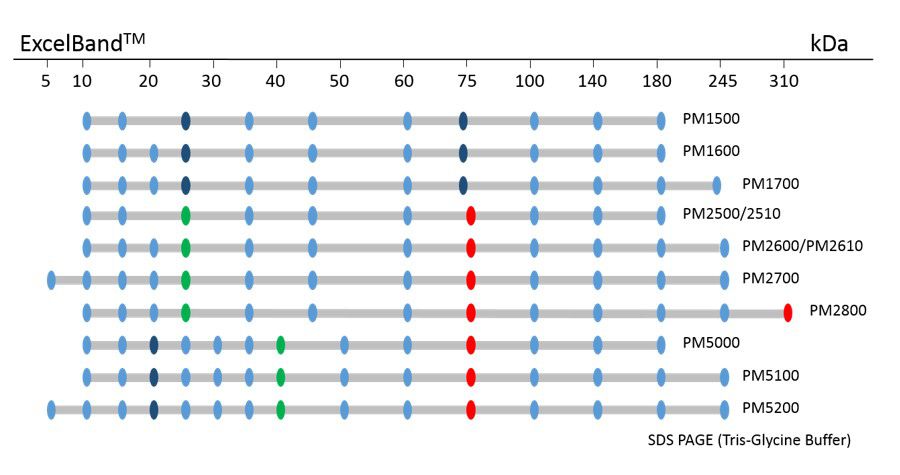
ExcelBand™ Protein Markers
Ready-to-use— premixed with a loading buffer for direct loading, no need to boil
Broad range— 310 kDa to 5 kDa
Pre-stained bands — for monitoring protein separation during electrophoresis and Western blotting transferring efficiency on membrane
Enhanced bands— for quick reference
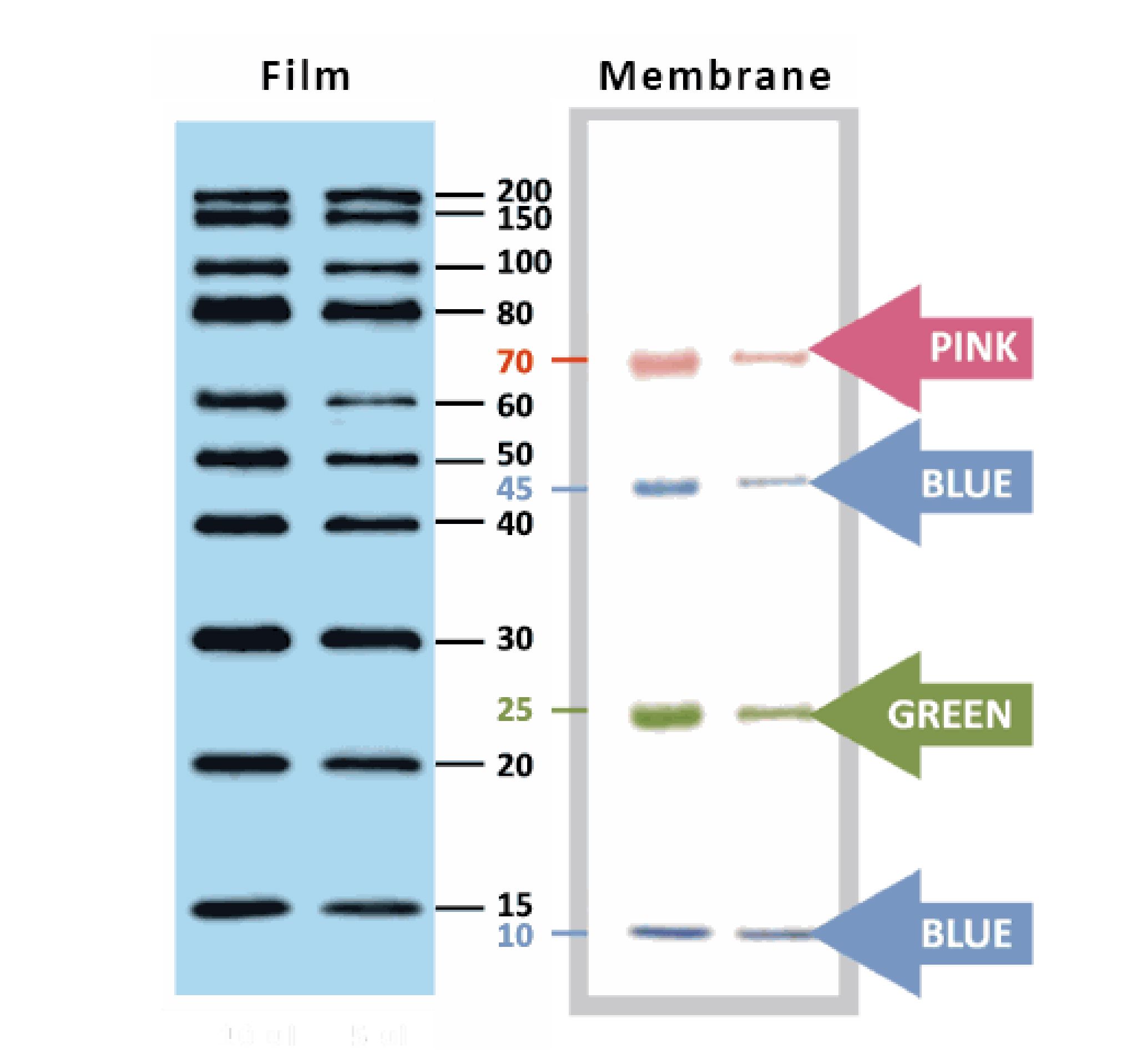
YesBlot™ Western Marker I
Ready-to-use — no need of mixing or heating before sample loading
Direct visualization — 10 IgG-binding proteins for direct visualization on Western blots
Pre-stained bands — 4 pre-stained proteins for monitoring protein separation during electrophoresis and Western blotting transferring efficiency on membrane
Wide range — 10 clear bands from 15 to 200 kDa for size estimation
Quick reference — two enhanced bands (30 and 80 kDa)
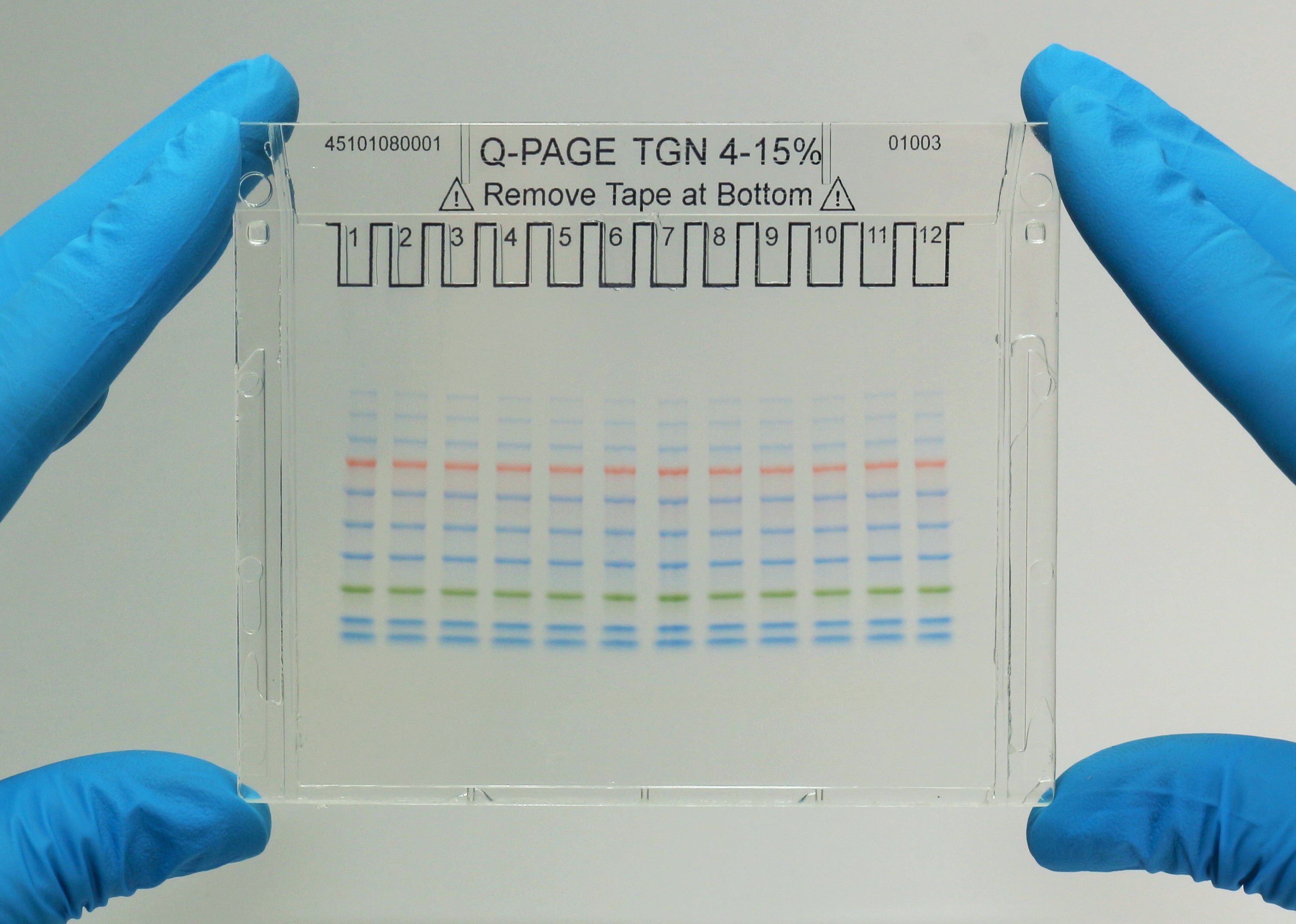
Q-PAGE™ Precast Gels
User-friendly gel cassette:
Numbered and framed wells for sample loading
Labeled warning sign and green tape as reminder
Enhanced gel performance:
Enhanced gel electrophoresis speed
Better band separation
Stable for shipping at ambient temperature
Easy compatibility:
Available as homogeneous and adjusted gradient gels for a wide range of protein separation.
Compatible with most popular protein electrophoresis systems

![[PM2500] ExcelBand™ 3-color Regular Range Protein Marker (9-180 kDa), 250 μl x 2](/web/image/product.template/245/image?unique=efaa6be)
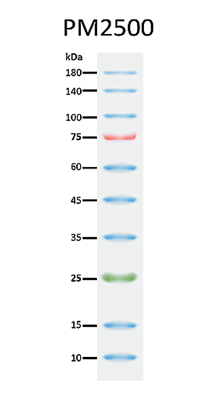
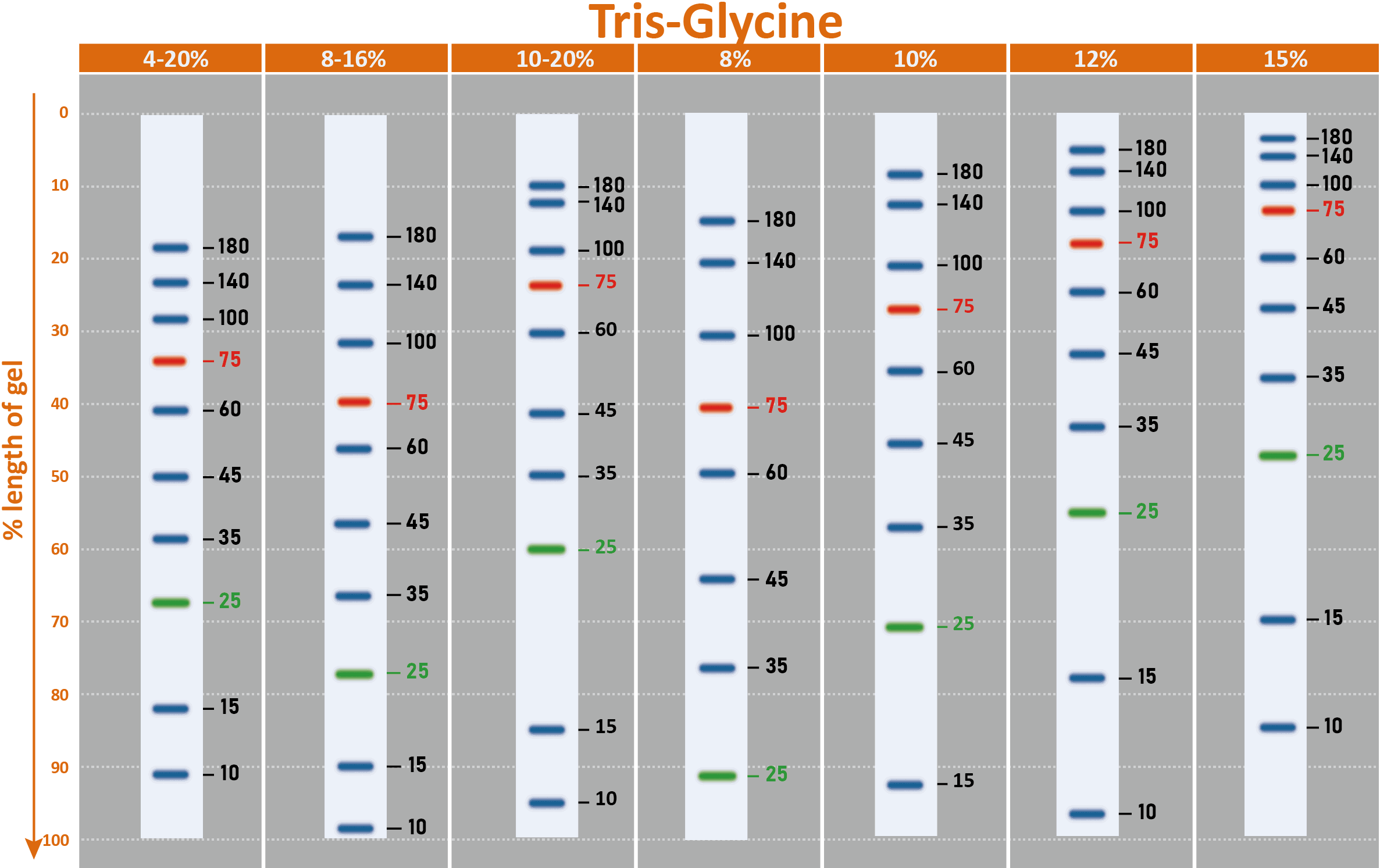

![[PM2500] ExcelBand™ 3-color Regular Range Protein Marker (9-180 kDa), 250 μl x 2](/website/image/product.template/245/image/90x90)



